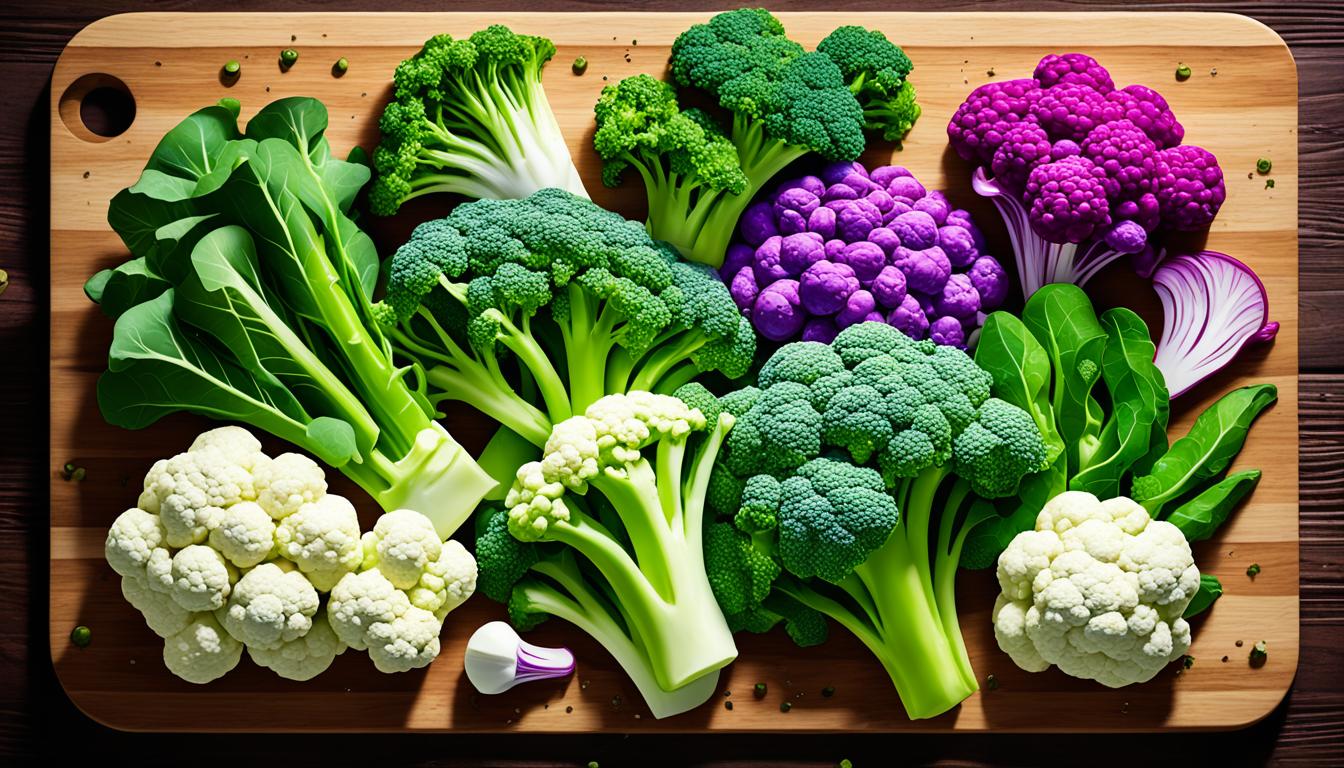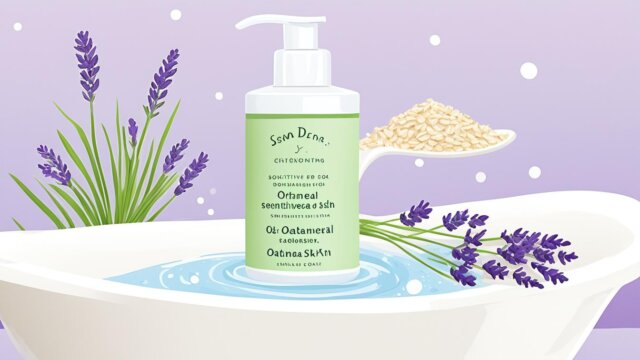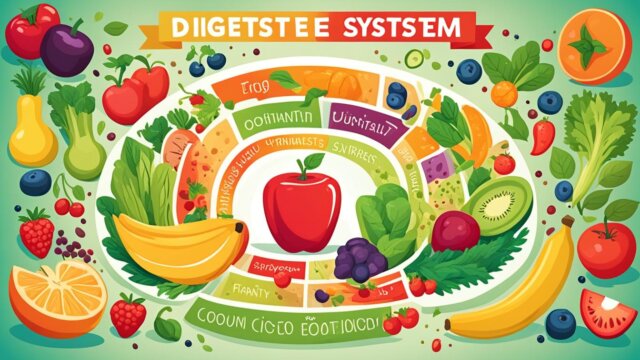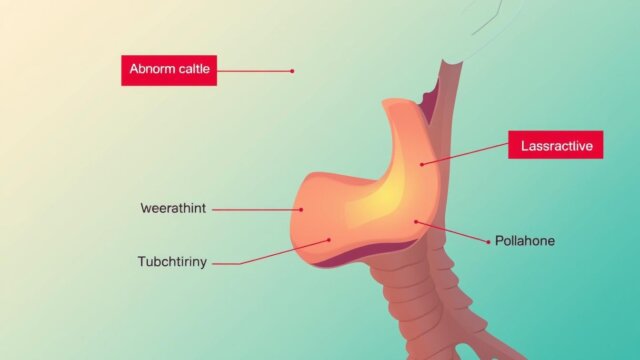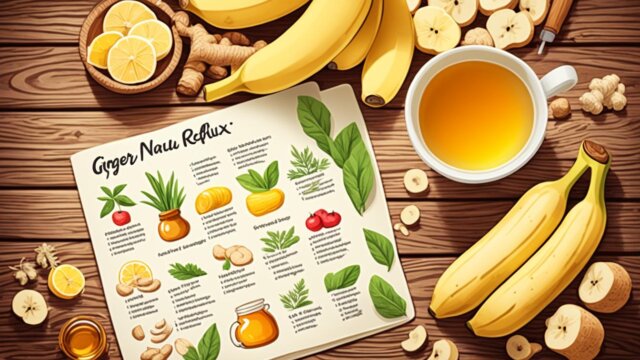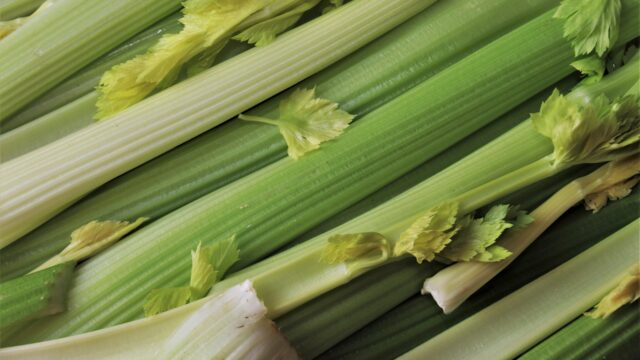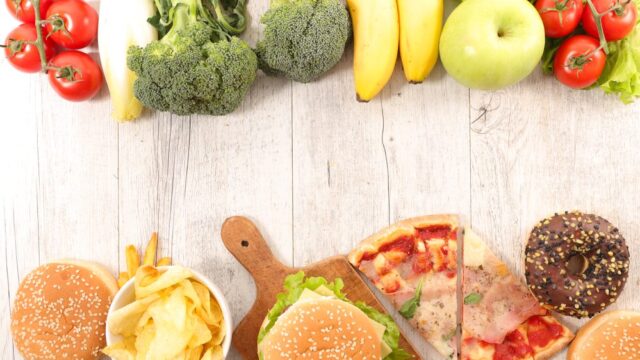FTC disclaimer: This post may contains affiliate links and we will be compensated if you click on a link and make a purchase.
Did you know there are over 3,000 types of cruciferous vegetables? These include broccoli, cauliflower, kale, and more. They have a special compound called glucosinolates. This compound helps fight inflammation and protect against harm from free radicals.
Cruciferous veggies are full of protein, fiber, vitamins, and minerals. Eating them can lower your risk of diseases like diabetes and Alzheimer’s. Just one serving can give you up to 20% of your daily fiber.
Key Takeaways
- Cruciferous vegetables are a diverse group of nutrient-dense greens with over 3,000 different species.
- They contain glucosinolates that offer strong anti-inflammatory and antioxidant benefits.
- Cruciferous veggies are high in protein, fiber, vitamins, and minerals.
- These vegetables are linked to a lower risk of chronic diseases like diabetes, asthma, and Alzheimer’s.
- A single serving can provide up to 20% of your daily fiber requirements.
What are Cruciferous Vegetables?
Cruciferous vegetables are also known as brassica vegetables. They belong to the Brassica genus. Their flowers look like a cross, which is why they are called cruciferous.
These veggies include broccoli, cauliflower, kale, and more. They have been grown for 5,000 years and are a big part of our food today.
Cruciferous Vegetable List
The family of cruciferous vegetables includes the Brassica genus and a few others. Here are some common ones:
- Broccoli
- Cauliflower
- Kale
- Brussels sprouts
- Cabbage
- Arugula
- Bok choy
- Radishes
- Mustard greens
- Collard greens
These veggies are grown in cool weather. People eat their leaves or buds, and sometimes roots or seeds. They are full of folate and vitamin K, and the green ones have lots of vitamin A and C.
Cruciferous vegetables are low in calories but high in fiber and nutrients. They help fight cancer because of the glucosinolate compounds they have.
The Importance of Cruciferous Vegetables in Your Diet
Cruciferous vegetables are packed with important nutrients. Adding them to your daily meals can greatly improve your health. These veggies are green and leafy. They share many health benefits, like fighting cancer, being high in fiber, and providing vitamins and minerals.
Experts say adults should eat at least 2½ cups of veggies every day. Cruciferous veggies like broccoli, cauliflower, and Brussels sprouts count as one cup. Also, two cups of raw leafy ones, like kale and bok choy, are the same as one cup.
Many studies have looked into how eating cruciferous veggies affects health. Some findings show they might lower the risk of certain cancers. This includes prostate, colorectal, lung, and breast cancer in women. They might also lower the risk of other cancers like bladder, endometrial, gastric, ovarian, pancreatic, and renal cancers.
Cruciferous veggies are full of compounds like glucosinolates. These can turn into isothiocyanates. These substances might help with detox and reduce inflammation. This could help protect against chronic diseases.
Adding different cruciferous veggies to your meals is easy and good for you. Broccoli, kale, Brussels sprouts, and cauliflower are great choices. They should be a key part of eating healthy.
Nutritional Profile of Cruciferous Vegetables
Cruciferous vegetables are packed with vitamins, minerals, and plant compounds. They are full of vitamins C, E, and K. These vitamins help with immune function, skin health, and blood clotting. They also have minerals like manganese, calcium, magnesium, and potassium. These minerals are important for strong bones, muscles, and nerves.
Vitamins and Minerals in Cruciferous Veggies
Broccoli is a top choice among these veggies. Eating one cup (90g) of raw broccoli gives you 91% of the daily vitamin C you need. It also gives you 77% of the daily vitamin K. Plus, it has 15% of the daily folate, which is key for cell growth. Broccoli is also packed with potassium, magnesium, iron, and calcium.
Nutrient | Amount in 1 Cup (90g) of Raw Broccoli | Percent of Daily Value (DV) |
|---|---|---|
Calories | 35 | – |
Protein | 2.3g | – |
Carbohydrates | 5.6g | – |
Fiber | 2.2g | 8% |
Fat | 0.3g | – |
Vitamin C | – | 91% |
Vitamin K | – | 77% |
Folate | – | 15% |
Other veggies like kale, cauliflower, Brussels sprouts, and cabbage are also part of this group. No matter the type, these veggies are among the healthiest foods you can eat.
Health Benefits of Cruciferous Vegetables
Cruciferous vegetables are packed with nutrients that are great for your health. They are full of compounds called glucosinolates. These may help fight cancer. Eating a lot of these veggies can lower the risk of getting cancers like breast, pancreatic, bladder, lung, prostate, and colon cancer.
Cancer Protection
These veggies are full of compounds that can help fight cancer. Glucosinolates from these veggies can stop cancer cells from growing and spreading. Studies show that these nutrients could be key in preventing cancer.
Improved Immunity Against Disease
Cruciferous vegetables also boost your immune system. They have things that fight off germs and protect against sickness. Stuff like sulforaphane in these veggies helps your body fight off sickness.
Adding different types of cruciferous vegetables to your meals is easy and beneficial. They help protect against cancer and boost your immune system. These foods are full of nutrients and should be a big part of your diet.
Fiber Content Aids Weight Loss
Cruciferous vegetables are great for your health and can help with weight loss. They are full of fiber, which makes you feel full and helps your digestion. A cup of kidney beans gives you a lot of the fiber you need each day.
The Academy of Nutrition and Dietetics says you should eat about 14 grams of fiber for every 1,000 calories you eat daily. The amount you need changes with age. Men aged 19-50 need 38 grams a day, and women in the same age group need 25 grams.
Most Americans only get about 15 grams of fiber a day, which is less than half of what they should. Eating more cruciferous vegetables can help fix this. For example, avocados have 6.7 grams of fiber per 100 grams, and broccoli gives you 2.6 grams per 100 grams.
Other fiber-rich cruciferous options include lentils, split peas, chickpeas, quinoa, and almonds.
Cruciferous vegetables are low in calories, making them great for weight loss diets. They are full of vitamins, minerals, and healthy fats. These can lower cholesterol, reduce inflammation, and help control blood sugar, aiding in weight loss and cancer prevention.
A single cup of chopped cauliflower has only 27 calories, 2 grams of fiber, and 2 grams of protein. A cup of cooked spaghetti squash has 42 calories, 10 grams of carbs, and 2 grams of fiber. Half an avocado gives you 120 calories, 6.5 grams of carbs, and 5 grams of fiber.
Adding these fiber-rich cruciferous vegetables to your meals can help with weight loss and improve your health.
Heart Health Benefits
Cruciferous veggies like broccoli, kale, and Brussels sprouts are great for your heart. They are full of nutrients and help your heart stay healthy. Eating a lot of these veggies can lower the risk of heart disease.
These veggies help by cutting down LDL (bad) cholesterol. The glucosinolates in them lower LDL cholesterol. This stops fatty deposits from building up in your arteries. This means you’re less likely to have heart attacks or strokes.
Eating more than 1.5 servings of raw cruciferous veggies a week can cut the risk of pancreatic cancer by 40%. Also, eating a lot of anthocyanins from these veggies can lower the risk of heart failure. Anthocyanins help your blood vessels work better, lower blood pressure, and fight against hardening of the arteries.
Adding more cruciferous veggies to your meals is simple and tasty. You can eat them raw, roasted, or add them to your favorite recipes. These veggies are key to a strong and healthy heart.
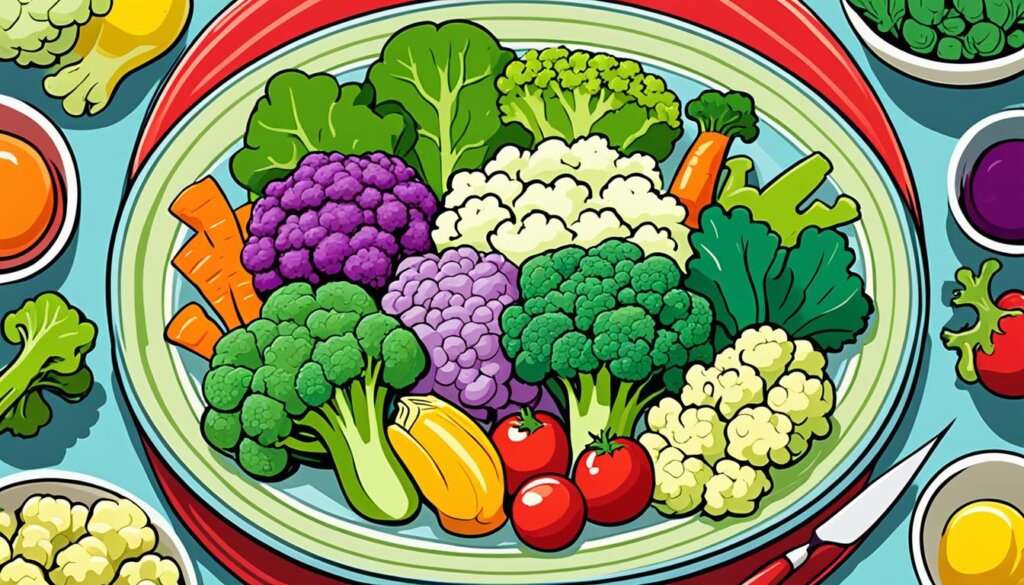
Cruciferous Vegetables Support Detoxification
Eating cruciferous vegetables can help your body clean itself. These veggies have sulforaphane and indole-3-carbinol (DIM). They help your liver work better and get rid of toxins and bad substances.
Sulforaphane is a compound in these veggies that keeps detoxification in balance. It stops too much toxin production and helps turn toxins into something you can get rid of. Foods like broccoli, cabbage, Brussels sprouts, and kale are full of sulforaphane and DIM. They are great for your detox efforts.
How you cook these veggies affects how well your body uses their nutrients. Steaming broccoli is best to get the most sulforaphane. You can also take sulforaphane and DIM supplements, but talk to a doctor first.
Enhancing Liver Function
The liver cleans your body, and cruciferous veggies help it do its job. Turmeric can help balance detox processes. Berries like blackberries, blueberries, raspberries, and strawberries fight free radicals and slow cancer cell growth.
Flax seeds are full of lignans and may help prevent some cancers by cleaning out bad estrogen. Eating different cruciferous veggies and other detox foods supports your liver in getting rid of toxins and keeping you healthy.
“Proper preparation of cruciferous vegetables impacts the absorption of sulforaphane and DIM, with steaming being the recommended method for obtaining sulforaphane from broccoli.”
Anti-Inflammatory Properties
Cruciferous veggies like broccoli, kale, and Brussels sprouts are superfoods. They are full of anti-inflammatory stuff. This is thanks to compounds like isothiocyanates and indoles. These help stop inflammation and reduce oxidative stress.
Isothiocyanates stop certain enzymes that make inflammatory molecules. Indoles fight free radicals and lessen oxidative stress damage. This is important for fighting inflammation.
Studies show that eating these veggies can lower the risk of heart disease and cancer. They also protect against damage from radiation and harmful chemicals.
These veggies might also help with metabolic health issues like diabetes and heart disease. Eating them can help reduce inflammation. This supports your overall health.
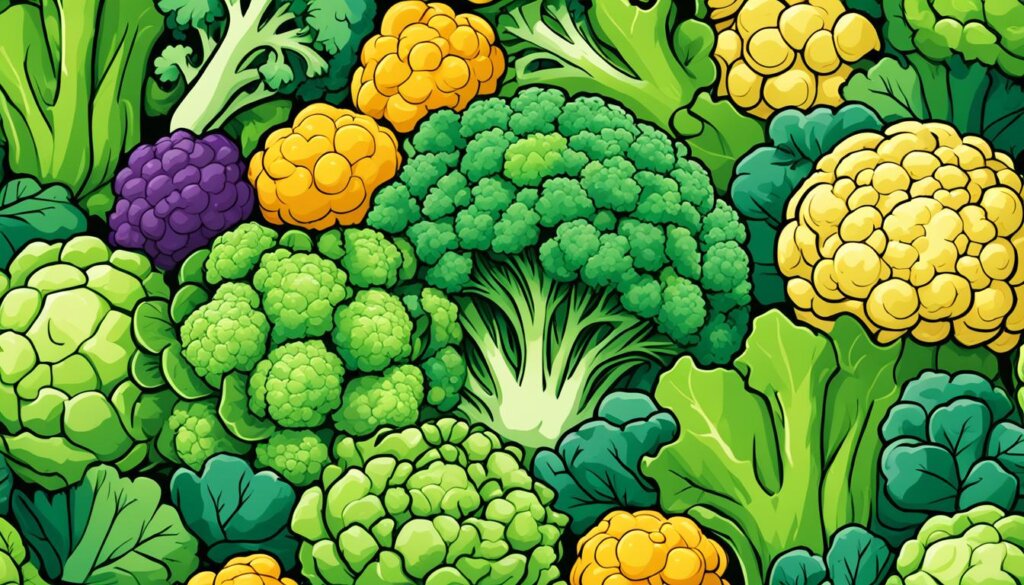
Role in Hormonal Balance
Cruciferous vegetables are key in keeping hormones in balance. They help stop too much estrogen, which is bad for health. Studies show that compounds in broccoli and Brussels sprouts slow down an enzyme that turns androgens into estrogens. This keeps estrogen and progesterone levels right, which is good for many health issues like bone health and cancer prevention.
Too much estrogen can cause many health problems, like breast cancer. It can also lead to issues like painful periods, endometriosis, and more. Eating cruciferous veggies helps get rid of extra estrogen, keeping hormones balanced.
Other foods also help with estrogen balance, like fiber, omega-3s, and certain vitamins. Eating a mix of these foods helps your body keep hormones in check and lowers estrogen-related risks.
Nutrient | Benefit for Hormonal Balance | Food Sources |
|---|---|---|
Fiber | Aids in the elimination of excess estrogen | Chia seeds, flaxseeds, oats, berries |
Reduce inflammation and support hormone production | Fatty fish, walnuts, flaxseeds | |
Selenium | Supports thyroid function and hormone regulation | Brazil nuts, seafood, poultry |
Adding these nutrients and cruciferous veggies to your diet helps with hormonal health. It also lowers the risk of estrogen-related issues.
Metabolic Health and Blood Sugar Regulation
Cruciferous veggies like broccoli, kale, and cauliflower are superfoods for your health. They help keep your metabolism healthy and control blood sugar levels. Studies show they can prevent obesity, insulin resistance, metabolic syndrome, and type 2 diabetes.
Sulforaphane in these veggies boosts how cells take in glucose. This is key for keeping blood sugar balanced. They are also low in calories and high in fiber. This helps you feel full and keeps a healthy weight, which is good for your metabolism.
- A study found eating a lot of cruciferous veggies lowered the risk of type 2 diabetes by 0.82.
- Vegetable fiber, like in these veggies, cuts the risk of type 2 diabetes to 0.87 over 10 years.
- Broccoli extract rich in sulforaphane helps control blood sugar.
- Eating foods like fatty fish, nuts, seeds, and berries also helps with metabolic health and blood sugar.
Adding cruciferous veggies to your meals helps keep blood sugar levels healthy and boosts metabolic health. Eating these nutrient-rich foods is a great way to stay healthy.
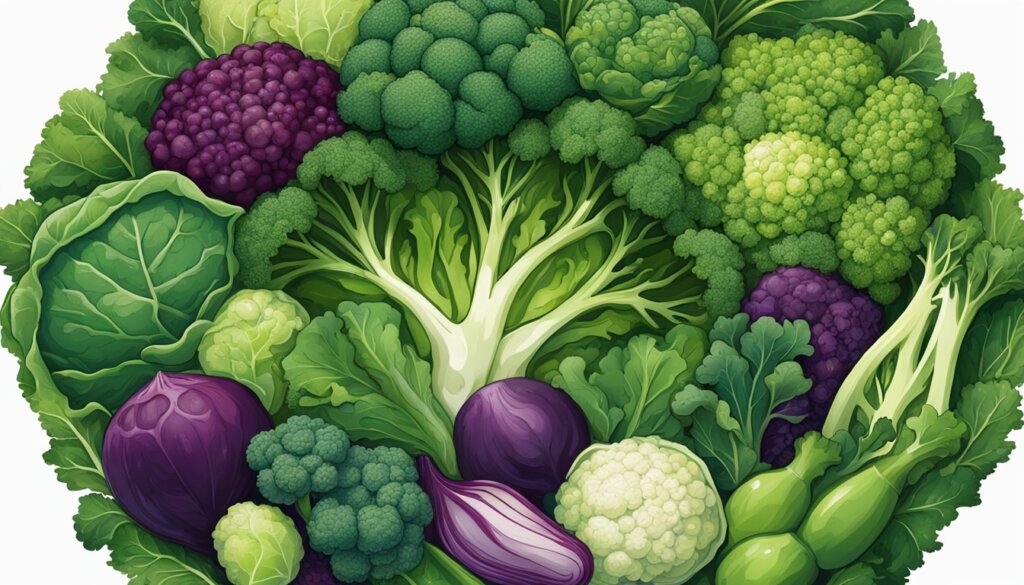
Recommended Portion Sizes
Cruciferous vegetables are key for health. They come in many types and are packed with nutrients. The USDA says we should eat 1.5 to 2.5 cups of them every week.
Eating three servings of these veggies weekly can cut your risk of prostate cancer by 41%. If you eat more plant-based foods, like these, by 20%, cancer rates can drop by 40%.
But, how you cook these veggies matters. Boiling can lower vitamins C and B, and some antioxidants. Yet, it can also make some nutrients like vitamin A easier for your body to use. Steaming is best for keeping nutrients, while boiling is worst. Microwaving, stir-frying, and eating them raw can also be good options.
Portion Sizes and Nutrient Preservation
- A standard serving of raw cruciferous veggies is 1/2 cup.
- One head of broccoli, cauliflower, or cabbage can feed 4 adults as a side.
- Try to eat 3 to 5 servings of these veggies each week.
Cooking Method | Nutrient Preservation |
|---|---|
Steaming | Highest nutrient retention |
Microwaving | Moderate nutrient retention |
Stir-frying | Moderate nutrient retention |
Sautéing | Moderate nutrient retention |
Boiling | Lowest nutrient retention |
Choosing the right portion sizes and cooking ways helps you get the most from cruciferous veggies.
Incorporating Cruciferous Vegetables into Your Meals
Adding cruciferous vegetables to your meals is easy and fun. These veggies, like broccoli, cauliflower, and kale, can be used in many ways. This makes sure you get their health benefits.
Begin your day with a green smoothie made with kale or spinach. Add arugula or bok choy to your lunch salad. Roast Brussels sprouts, radishes, and turnips as a tasty side dish. Sauté shredded cabbage or collard greens to add to soups and stews. There are so many ways to use them!
Try different cooking ways to find your favorite cruciferous veggies. Steaming, sautéing, or blending them with ingredients like raspberry jelly or potatoes can make them taste great.
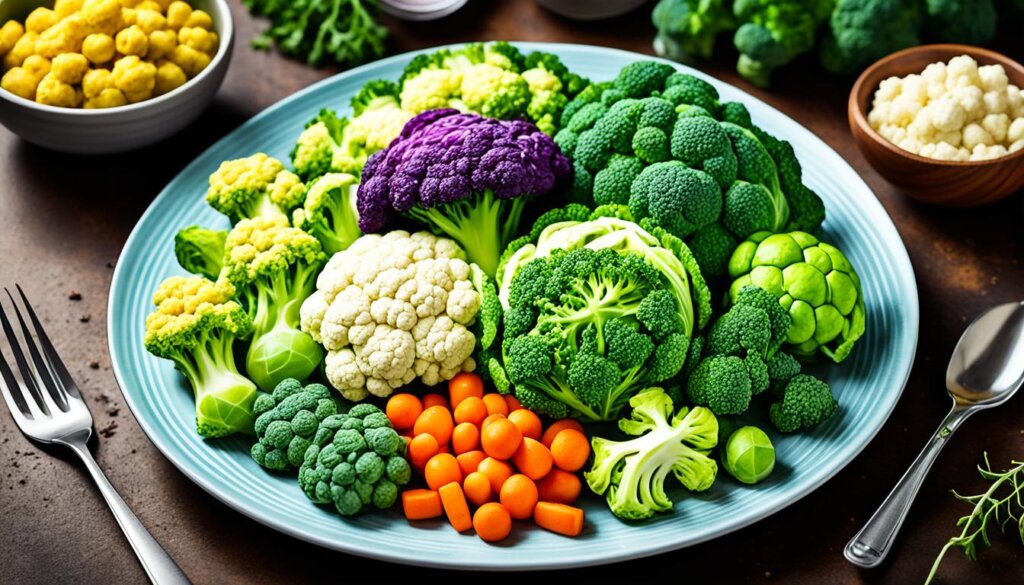
For the best results, eat a variety of colorful cruciferous veggies each week. Dietitians suggest eating at least 5 servings of veggies daily. Two of those should be calcium-rich greens. Adding these veggies to your meals helps you meet your vegetable goals and enjoy their flavors and textures.
Cruciferous Vegetable | Preparation Method |
|---|---|
Broccoli | Roast, steam, or sauté |
Cauliflower | Roast, steam, or blend into a creamy soup |
Kale | Massage with lemon juice and olive oil, or blend into a smoothie |
Brussels Sprouts | Roast with garlic and parmesan, or shred and sauté |
Cabbage | Sauté with onions and carrots, or use in a crunchy slaw |
Using a mix of cruciferous vegetables in your meals is the best way to get their benefits. Try different ways of cooking to find what you like best.
“Eating a diet rich in vegetables, including cruciferous veggies, is one of the best things you can do for your health.”
– Dr. Michael Greger, author, and nutrition expert
Cruciferous Vegetables in a Nutshell
Cruciferous vegetables are packed with nutrients and belong to the Brassicaceae family. They are grown and eaten all over the world. These veggies have a strong smell and taste thanks to sulfur compounds.
There are over 3,000 types of these veggies. They include leafy greens, roots, and other parts like broccoli, kale, and cauliflower. These plants are full of vitamins, minerals, and phytochemicals that are good for our health.
Cruciferous veggies are full of nutrients like lutein, zeaxanthin, and beta-carotene. They also have compounds that can fight cancer. Eating these veggies often may lower the risk of cancer.
They are also high in fiber and antioxidants, which help our gut health. The USDA says we should eat at least 1.5 cups of these veggies a week. Cooking them right, like steaming or sautéing, can also help avoid stomach issues.
Eating different types of cruciferous veggies can make us healthier. Eating the right amount of indole-3-carbinol can also be good for us. These veggies are key to a healthy diet.
Potential Downsides and Precautions
Cruciferous vegetables are great for health, but watch out for some downsides. If you have sensitive digestion or conditions like Crohn’s disease, IBS, or celiac disease, they might cause bloating and discomfort.
Cruciferous vegetables can affect blood thinners if eaten too much. So, if you’re on blood thinners or have bleeding issues, don’t eat too many of these veggies.
Some think cruciferous vegetables hurt thyroid health, but that’s not true. They actually help with thyroid function and hormone balance. But, eating too much, especially raw, can be bad for thyroid health.
To stay healthy and avoid problems, eat cruciferous vegetables in moderation. Always talk to a doctor if you have health concerns. This way, you can enjoy their benefits without the risks.
Delicious Cruciferous Vegetable Recipes
Cruciferous vegetables are great for many dishes. They are full of nutrients and add flavor and texture to meals. Enjoy them raw, steamed, roasted, or in soups and stews to make your meals healthier.
Cauliflower is a top choice among these veggies. It can be made into many dishes like steaks, rice, and pizza crust. Roasting it is easy and tasty, and you can add spices and herbs you like.
Kale is another favorite. You can eat it raw in salads or make it soft with oil and lemon. It’s also good sautéed with garlic or baked into crispy chips. Brussels sprouts, broccoli, and cabbage are great too and can be cooked in many ways.
Cruciferous veggies are perfect for many dishes. Try new recipes and methods to find your favorites.
“Incorporating cruciferous vegetables into your meals is a simple and delicious way to boost your overall health and well-being.”
Conclusion
Cruciferous vegetables are packed with nutrients and offer many health benefits. They have special compounds like glucosinolates and indole-3-carbinol. These veggies are full of vitamins, minerals, and fiber. Adding them to your meals can help prevent cancer, boost your immune system, and keep your heart healthy.
Studies show that these veggies can greatly improve your health. They can lower the risk of lung and colorectal cancers. They also help with weight control and managing blood sugar. Adding cruciferous veggies to your meals is a smart way to stay healthy.
Keep exploring the many ways to use cruciferous vegetables in your cooking. Try different cooking methods to keep their nutrients. Find fun ways to add them to your favorite dishes. These veggies are tasty and can make your diet better, helping you live a healthier life.
FAQ
What are cruciferous vegetables?
Cruciferous vegetables are green foods from the Brassicaceae family. They include broccoli, cauliflower, kale, and more. You’ll also find Brussels sprouts, cabbage, arugula, and radishes in this group.
What are the health benefits of cruciferous vegetables?
These veggies help fight chronic diseases like cancer and heart disease. They’re full of nutrients, fiber, and compounds that fight inflammation and protect against harm.
How much of these vegetables should I be eating?
The USDA suggests eating 1.5 to 2.5 cups of cruciferous veggies weekly. Eating three servings of veggies daily, including these, can help slow aging and lower disease risk.
How do I incorporate more cruciferous vegetables into my diet?
Add them to salads, soups, stews, and smoothies. Roast Brussels sprouts and radishes, sauté bok choy, or blend kale into your favorite dishes.
Are there any downsides to eating cruciferous vegetables?
If you have digestive issues like IBS or Crohn’s, they might cause bloating and gas. They can also affect blood thinners, so be careful with your meds. But, they don’t worsen thyroid problems like some think.
